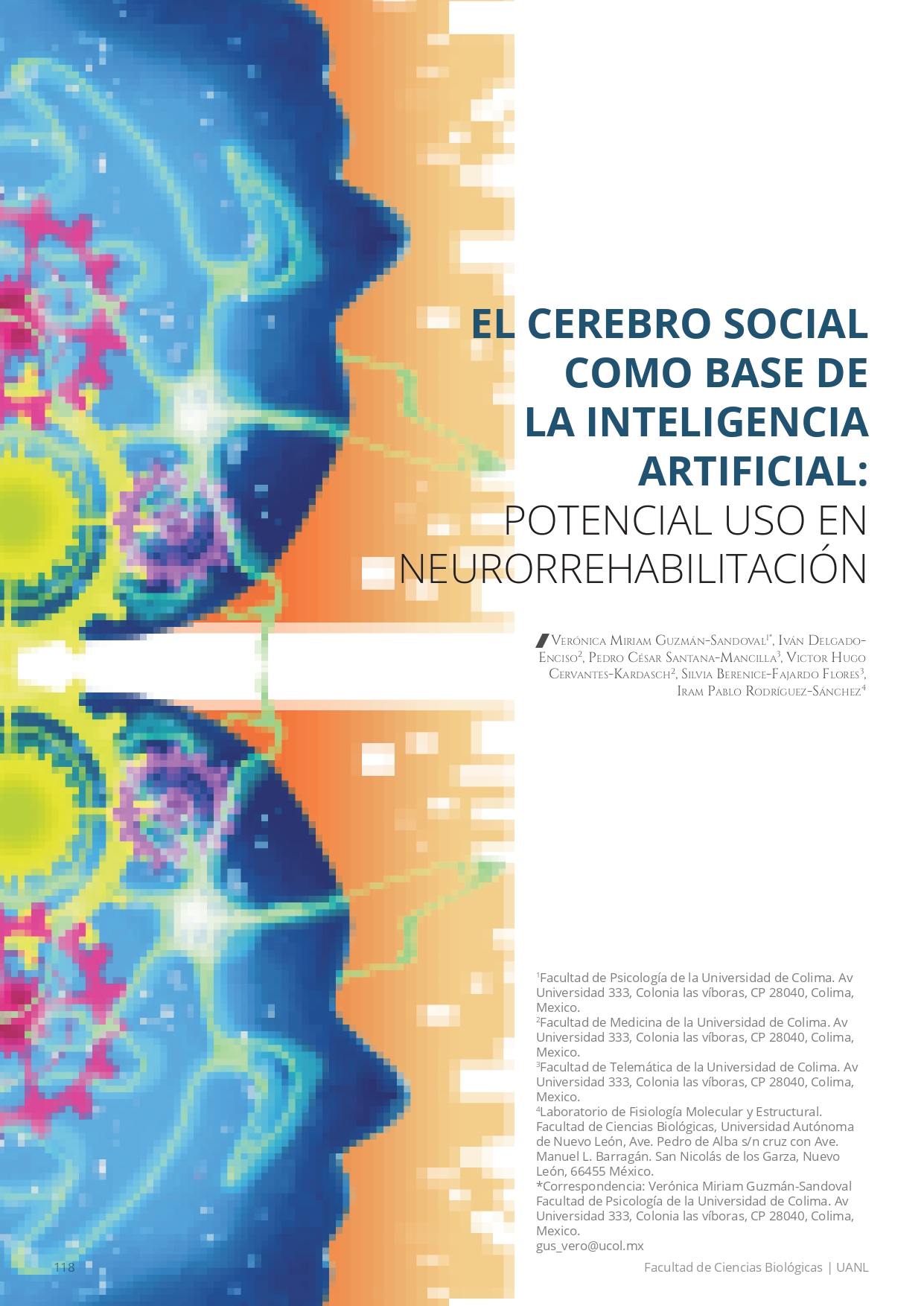El cerebro social como base de la inteligencia artificial
Potencial uso en neurorrehabilitación
DOI:
https://doi.org/10.29105/bys8.16-198Palabras clave:
discapacidad neurológica, discapacidad cognitiva, salud, calidad de vida, inteligencia artificialResumen
La evolución del cerebro para su humanización, socialización y adaptación a un entorno cambiante ha tomado millones de años. El entendimiento completo de las funciones cerebrales y de las habilidades socioemocionales aún no se conoce con profundidad, pero se sabe que el tamaño y la complejidad del cerebro humano proviene de las demandas de la interacción social. Con la aparición de la neurociencia cognitiva se comprende el cerebro social, que conforma una interacción de redes neuronales y neurotransmisores involucrados en el proceso de aprendizaje; con estos conocimientos del funcionamiento de las redes neuronales se desarrollan modelos matemáticos para generar la inteligencia artificial. La inteligencia artificial puede contribuir a la neurorrehabilitación y en la habilitación socioemocional de personas con diversas discapacidades neurológicas, bajo leyes y principios éticos que garanticen su calidad de vida
Descargas
Citas
Adolphs R. (2009). The social brain: neural basis of social knowledge. The Annual Review of Psychology; 60, 693-716. https:// DOI: https://doi.org/10.1146/annurev.psych.60.110707.163514
doi.org/10.1146/annurev.psych.60.110707.163514
Arias, V., Salazar, J., Garicano, C., Contreras, J., Chacón, G. Chacín-González, M. Añez, R., Rojas, J., Bermúdez-Pirela, V. (2019). Una introducción a las aplicaciones de la inteligencia artificial en Medicina: Aspectos históricos. Revista Latinoamericana
de Hipertensión; 14(5), 580-609. https://www.redalyc.org/articulo.oa?id=170262877013
Cabanelas, J. (2019). Inteligencia artificial ¿Dr. Jekyll o Mr. Hyde? Mercados y Negocios; 40, 4-16. https://www.redalyc.org/articulo.oa?id=571860888002 DOI: https://doi.org/10.32870/myn.v0i40.7403
Calderone, A., Latella, D., Bonanno, M., Quartarone, A., Mojdehdehbaher, S., Celesti, A., & Calabrò, R. S. (2024). Towards Transforming Neurorehabilitation: The Impact of Artificial Intelligence on Diagnosis and Treatment of Neurological Disorders. Biomedicines; 12(10),2415. https://pubmed.ncbi.nlm.nih.gov/39457727/ DOI: https://doi.org/10.3390/biomedicines12102415
Castañeda. A., Roldan, P., Vega, F. (2022). Redes neuronales artificiales: una medición de aprendizajes de pronósticos como demanda potencial. Universidad, Ciencia y Tecnología; 27(118), 51-60. https://doi.org/10.47460/uct.v27i118.686 DOI: https://doi.org/10.47460/uct.v27i118.686
Di Paolo, E., & De Jaegher, H. (2012). The interactive brain hypothesis. Frontiers in Human Neuroscience; 6(163), 1-16. 10.3389/fnhum.2012.00163 DOI: https://doi.org/10.3389/fnhum.2012.00163
Dunbar, R.I. (2009). The social brain hypothesis and its implications for social evolution. Annals of Human Biology; 36(5),562-72.
10.1080/03014460902960289 DOI: https://doi.org/10.1080/03014460902960289
Dunbar, R.I., & Shultz, S. (2007). Evolution in the social brain. Science; 7,317(5843),1344-7. 10.1126/science.1145463 DOI: https://doi.org/10.1126/science.1145463
Dunbar, R.I. (1993) Coevolution of neocortical size, group size and language in humans. Behavioral and Brain Sciences; DOI: https://doi.org/10.1017/S0140525X00032325
11,681–735.
Dunbar, R.I. (2012). The social brain meets neuroimaging. Trends in Cognitive Sciences; 16(2),101-2. 10.1016/j.tics.2011.11.013 DOI: https://doi.org/10.1016/j.tics.2011.11.013
Fiorente, N., Mojdehdehbaher, S., & Calabrò, R. S. (2024). Artificial Intelligence and Neurorehabilitation: Fact vs. Fiction. Innovation
in Clinical Neuroscience;1(21),1-3. https://pubmed.ncbi.nlm.nih.gov/38495602/
Fiske, A., Henningsen, P., & Buyx, A. (2019). Your Robot Therapist Will See You Now: Ethical Implications of Embodied Artificial
Intelligence in Psychiatry, Psychology, and Psychotherapy. The Journal of Medical Internet Research; 21(5), e13216.
10.2196/13216 DOI: https://doi.org/10.2196/13216
Forero-Corba, W., y Negre, F. (2024). Técnicas y aplicaciones del Machine Learning e Inteligencia Artificial en educación: una revisión sistemática. RIED-Revista Iberoamericana de Educación a Distancia; 27(1), 1-34. DOI: https://doi.org/10.5944/ried.27.1.37491
GBD 2019 Dementia Collaborators (2021). The Burden of Dementia due to Down Syndrome, Parkinson’s Disease, Stroke, and Traumatic Brain Injury: A Systematic Analysis for the Global Burden of Disease Study 2019. Neuroepidemiology; 55(4), 286-296. 10.1159/000515393 DOI: https://doi.org/10.1159/000515393
Goerlich, K. S., Votinov, M., Lammertz, S. E., Winkler, L., Spreckelmeyer, K. N., Habel, U., Gründer, G., & Gossen, A. (2017). Effects of alexithymia and empathy on the neural processing of social and monetary rewards. Brain Structure and Function; 222(5), 2235-2250. 10.1016/j.tics.2011.11.013 DOI: https://doi.org/10.1007/s00429-016-1339-1
Guez-Barber, D., Eisch, A.J., & Cristancho, A.G. (2023). Developmental Brain Injury and Social Determinants of Health: Opportunities to Combine Preclinical Models for Mechanistic Insights into Recovery. Developmental of neuroscience; 45(5):255-267. 10.1159/000530745 DOI: https://doi.org/10.1159/000530745
Hari, R., Henriksson, L., Malinen, S., & Parkkonen, L. (2015). Centrality of Social Interaction in Human Brain Function. Neuron; DOI: https://doi.org/10.1016/j.neuron.2015.09.022
7;88(1):181-93. 10.1016/j.neuron.2015.09.022
Jimenez, C. A., & Meyer, M. L. (2024). The dorsomedial prefrontal cortex prioritizes social learning during rest. Proceedings of the National Academy of Sciences of the United States of America; 19;121(12), e2309232121. 10.1073/pnas.2309232121 DOI: https://doi.org/10.1073/pnas.2309232121
Juárez, A., Murie-Fernández, M. (2023). Nuevas tecnologías e inteligencia artificial en neurorrehabilitación. Kranion;18, 65-71 DOI: https://doi.org/10.24875/KRANION.M23000056
Larraín-Valenzuela, J., Herrera-Guzmán, Y., Mardones, F., Freire,Y., Kausel, L., Aboitiz, F. (2022). Aportes históricos de la neurociencia cognitiva y su emergencia en Chile. Revista Médica de Chile; 150,368-380. https://www.scielo.cl/pdf/rmc/v150n3/0717-6163-rmc-150-03-0368.pdf DOI: https://doi.org/10.4067/S0034-98872022000300368
McCulloch, W. S, & Pitts W. (1943). A logical calculus of the ideas immanent in nervous activity. Bulletin of Mathematical Biophysics, 5, 115-133. DOI: https://doi.org/10.1007/BF02478259
Pham, K.T, Nabizadeh, A., & Selek, S. (2022). Artificial Intelligence and Chatbots in Psychiatry. Psychiatric Quarterly; 93(1), 249-253. 10.1007/s11126-022-09973-8 DOI: https://doi.org/10.1007/s11126-022-09973-8
Rosales-Reynoso, C. I., Juárez-Vázquez, P., & Barros-Núñez (2015). Evolución y genómica del cerebro humano. Neurología;
33(4).10.1016/j.nrl.2015.06.002
Rosenblatt, F. (1958). The perceptron: A probabilistic model for information storage and organization in the brain. Psychological DOI: https://doi.org/10.1037/h0042519
Review, 65(6), 386–408. 10.1037/h0042519.
Sato, M., Nakai, N., Fujima, S., Choe, K.Y., & Takumi, T. (2023). Social circuits and their dysfunction in autism spectrum disorder. Molecular Psychiatry; 28(8), 3194-3206. 10.1038/s41380-023-02201-0 DOI: https://doi.org/10.1038/s41380-023-02201-0
Shultz, S., & Dunbar, R. I. (2007). The evolution of the social brain: anthropoid primates contrast with other vertebrates. Proceedings of the Royal Society B: Biological Sciences; 274(1624), 2429-36. 10.1098/rspb.2007.0693
Scheerer, N.E., Boucher, T.Q., Larocci, G. (2021). Alexithymia is related to poor social competence in autistic and nonautistic DOI: https://doi.org/10.1002/aur.2485
children. Autism Research;14(6), 1252-1259. 10.1002/ aur.2485
Zapata, L. E. (2009). Evolución, cerebro y cognición. Psicología desde el Caribe; 24, 106-119. https://www.redalyc.org/pdf/213/21312270006.pdf







